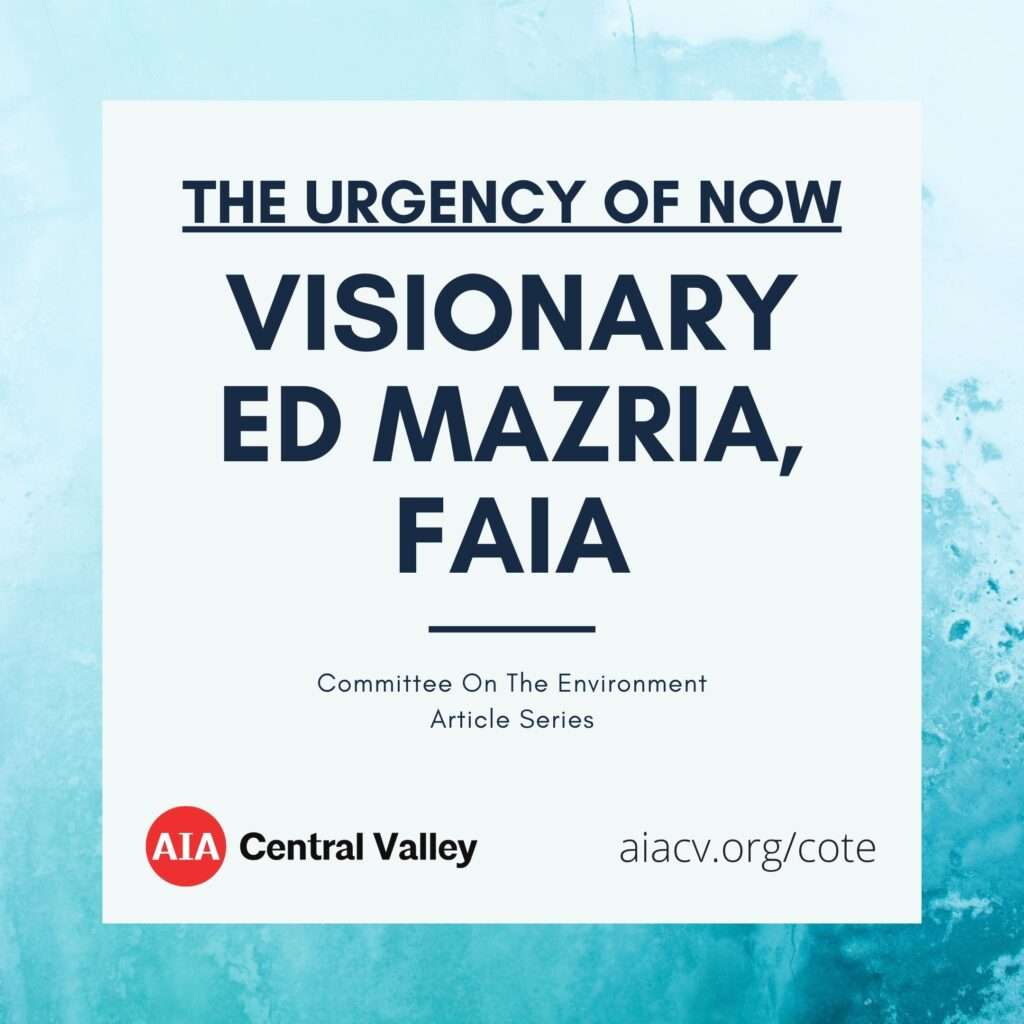
by Susan Rainer, AIA
AIACV COTE Member
Although we have not had a VISIONARY event for some time, Ed Mazria certainly qualifies as a leading edge thinker and innovator with enlightened ideas. In fact, he can be called a true pioneer in the movement to fight climate change – seeing that buildings are of top importance in transforming to clean energy starting back in the 1970’s.
In researching Edward Mazria I was especially pleased to find out he was a professional basketball player drafted by the New York Knickerbockers in 1962 after college. Knowing team strategies and tenacious desires to win cannot be lost with this experience!
Another very significant experience is that after receiving his Bachelor of Architecture Degree from the Pratt Institute in 1963 he spent two years as an architect in the Peace Corps in Arequipa, Peru. Every person I’ve met who has had Peace Corp experience have had a special energy and understandings about the interpersonal and interconnectedness of our world. In fact, this experience in Peru may have been what influenced him to go deeply into passive solar designs. (By the way, Arequipa is the half-way point for people to stay for acclimating one’s body before going to the heights of Cuzco – site of extraordinary Inca ruins.)
Mazria later worked with the firm of Edward Larrabee Barnes in New York before completing his master’s degree, starting a teaching and research career at the University of New Mexico in 1973.
His architecture and renewable energy research at both University of New Mexico and the University of Oregon where he shined as an expert in the field of resource conservation and passive heating, cooling and daylighting design. Mazria’s design methodology, had a global influence with the textbook: The Passive Solar Energy Book , Rodale Press 1979.
Mazria Associates, Inc. in 1978, churned out award-winning architecture and planning projects from the day-lit Mt. Airy Public Library in North Carolina to the Rio Grande Botanic Garden Conservatory in New Mexico. Please check out these projects online.
Passive Solar Energy is a no-brainer for California. Far fewer photovoltaics would be required for electric devices if good passive solar designs would be used. Better construction techniques, better insulation, tighter structures for air tightness is not so expensive yet the returns on investments are phenomenal.
Also, I’ve seen the Arco Arena photos of the steels frame before cladding. It would be perfect for transformation into a Passive Solar Botanical Garden for Sacramento and all the parking and roads for big crowds are already there! Let’s start a movement to transform it to something much more beautiful! Kids of all ages love botanical gardens. It would be a nice complement to the Science Center across the highway. Maybe we can get Ed to help us!
Mazria closed his architecture practice in 2006 and is currently the Founder and CEO of Architecture 2030, a stellar think tank (interconnected open forum ideas). His phenomenal works include the AIA+2030 Professional Education Series, 2030 Palette, China Accord, and the 2030 Districts movement in North American cities. He developed the “Roadmap to Zero Emissions” and is currently working with cities across the U.S. to develop pathways for “zero” to “80%” greenhouse gas emissions reductions by 2030. He has been on webinar calls here in California, that I was on. He is a soft-spoken man and plain speaker, quite humble. I first met him at my first International Living Future Conference where he was honored as a trailblazer. We were shown a lot of his other projects – he seems to be a precursor for organic, sustainable, connected to nature designing.
I encourage everyone to visit the Architecture 2030 site:
Note the stellar alliances that he has made:
| AIA (Well, he may be who has influence AIA to now be only COTE for TOP TEN in design) AIA Large Roundtable Autodesk ACSA C40Cities CLF CNCA C6 | ClimatePositiveDesign CNU DesignIntelligence Edge Global Alliance for Buildings and Construction Living Future Movement Strategy Center NBI Net-Zero Energy Coalition OAA | Race Forward RAIC / IRAC Resource Media Rocky Mountain Institute Sefaira Track UNFCC USDN World Green Building Council |
He’s written articles for several magazines: It’s the Architecture Stupid!, Solar Today Magazine, May/June 2003; Turning Down the Global Thermostat, Metropolis Magazine, October 2003; Blueprint for Disaster, On Earth Magazine, Summer 2005.
His building designs have been published in Architecture, Progressive Architecture, Metropolis, Architectural Record, Landscape Architecture, Architectural Digest, Process, Kenchiku Bunka, Public Garden, Solar Today, ArchitectureWeek, Texas Architect, The Wall Street Journal and the New York Times.
Perhaps the most significant gift he’s given the climate movement is to bring understanding of the contribution to pollution that buildings are responsible for on a global scale. Mazria has reshaped the national and international dialogue on global warming to incorporate building design as the “Building Sector”.
He authored the AIA’s position statement and the U.S. Conference of Mayor’s Resolution #50 adopting the “2030 Challenge” as a means of dramatically reducing building sector greenhouse gas emissions. His report, “Roadmap to Zero Emissions” submitted to the UN Framework Convention on Climate Change, outlines his strategy for addressing what he believes is today’s most pressing global challenge.
This spring, Ed Mazria, FAIA, will receive the AIA’s highest individual honor, the Gold Medal.
Ed Mazria is a true hero and his works have influenced the AIA in a direction that has now made zero energy, highly sustainable designs = Design Awards. Gone are the vanity projects! Frankly, the new highly sustainable designs do seem to be much more beautiful. Bravo Ed Mazria!
